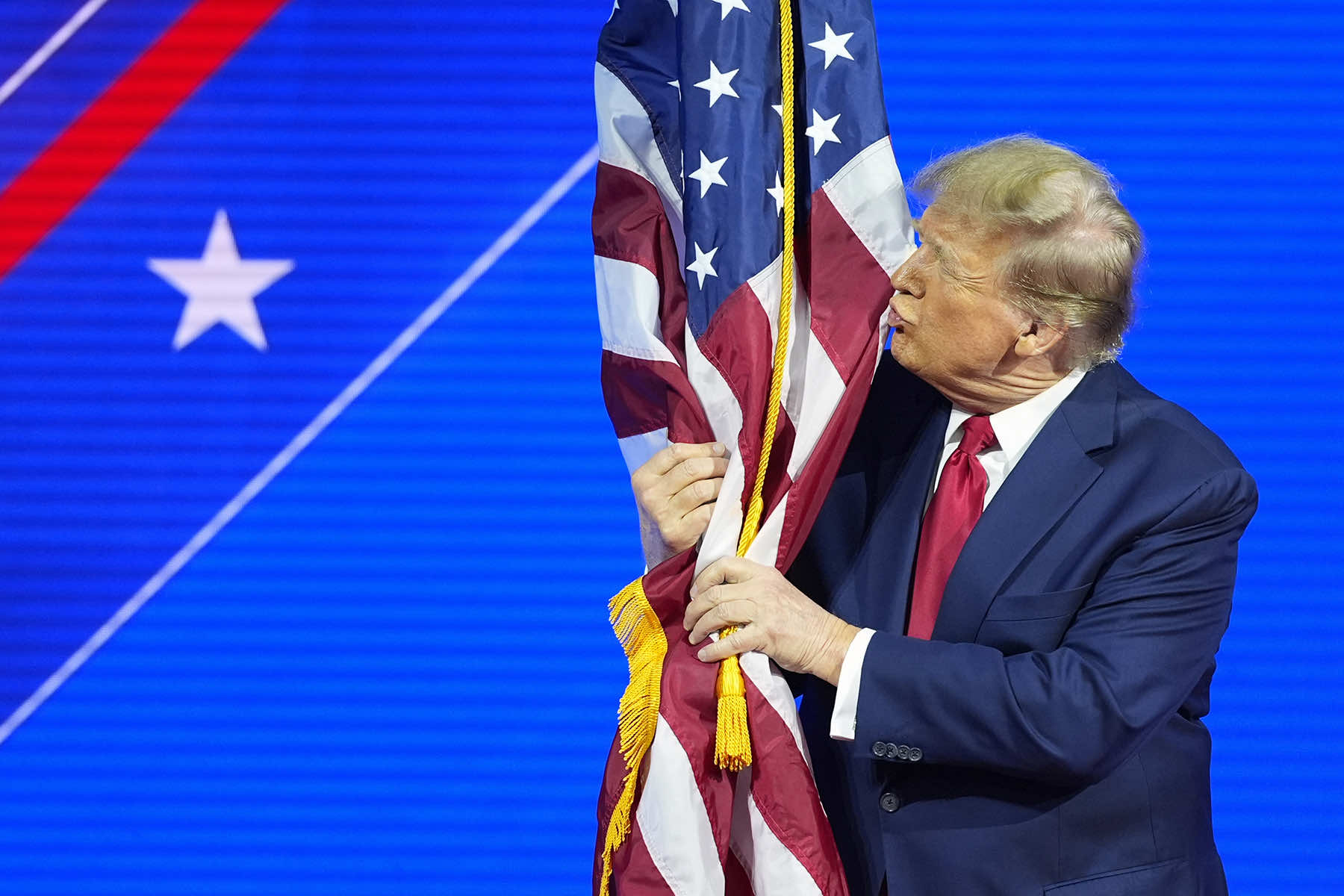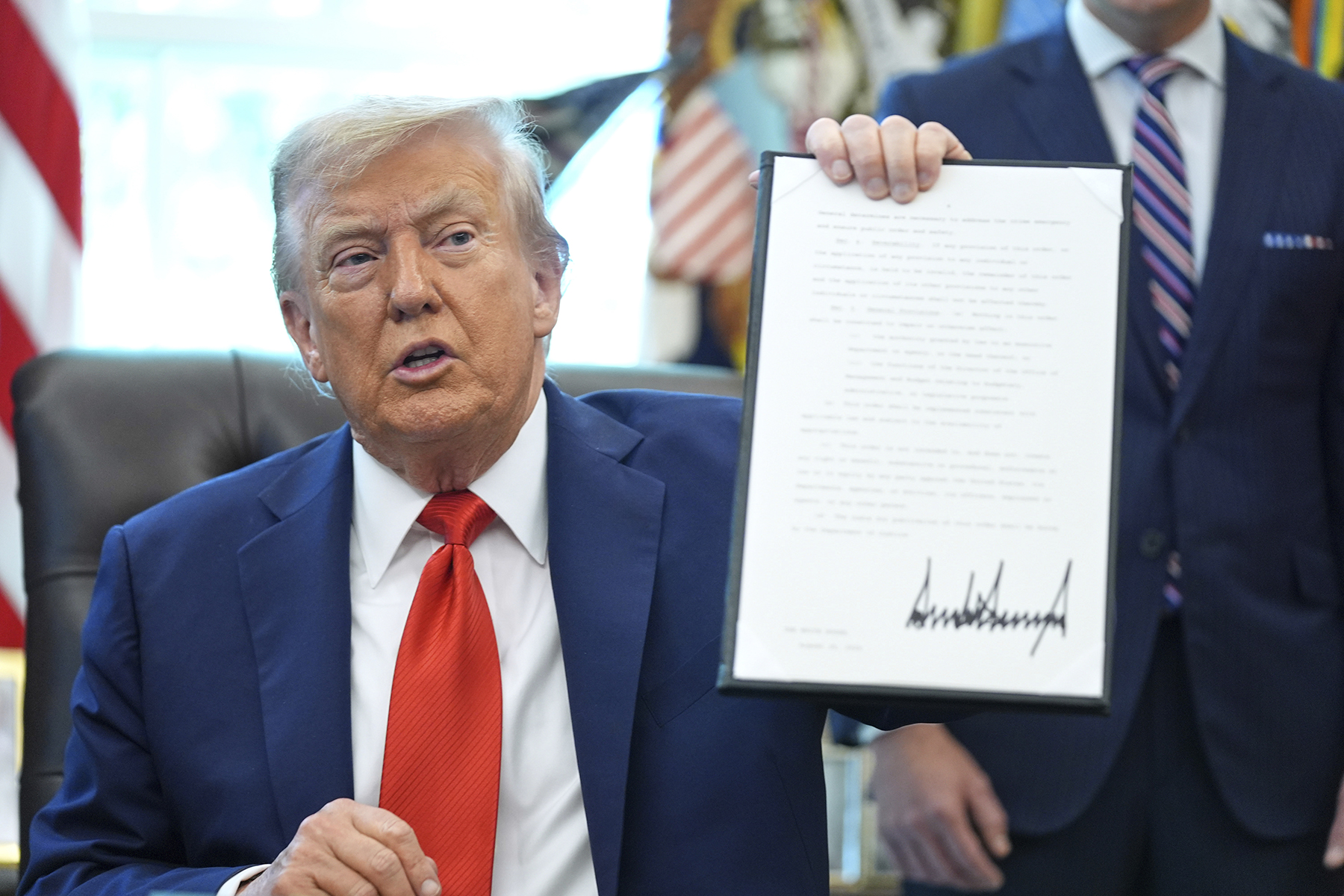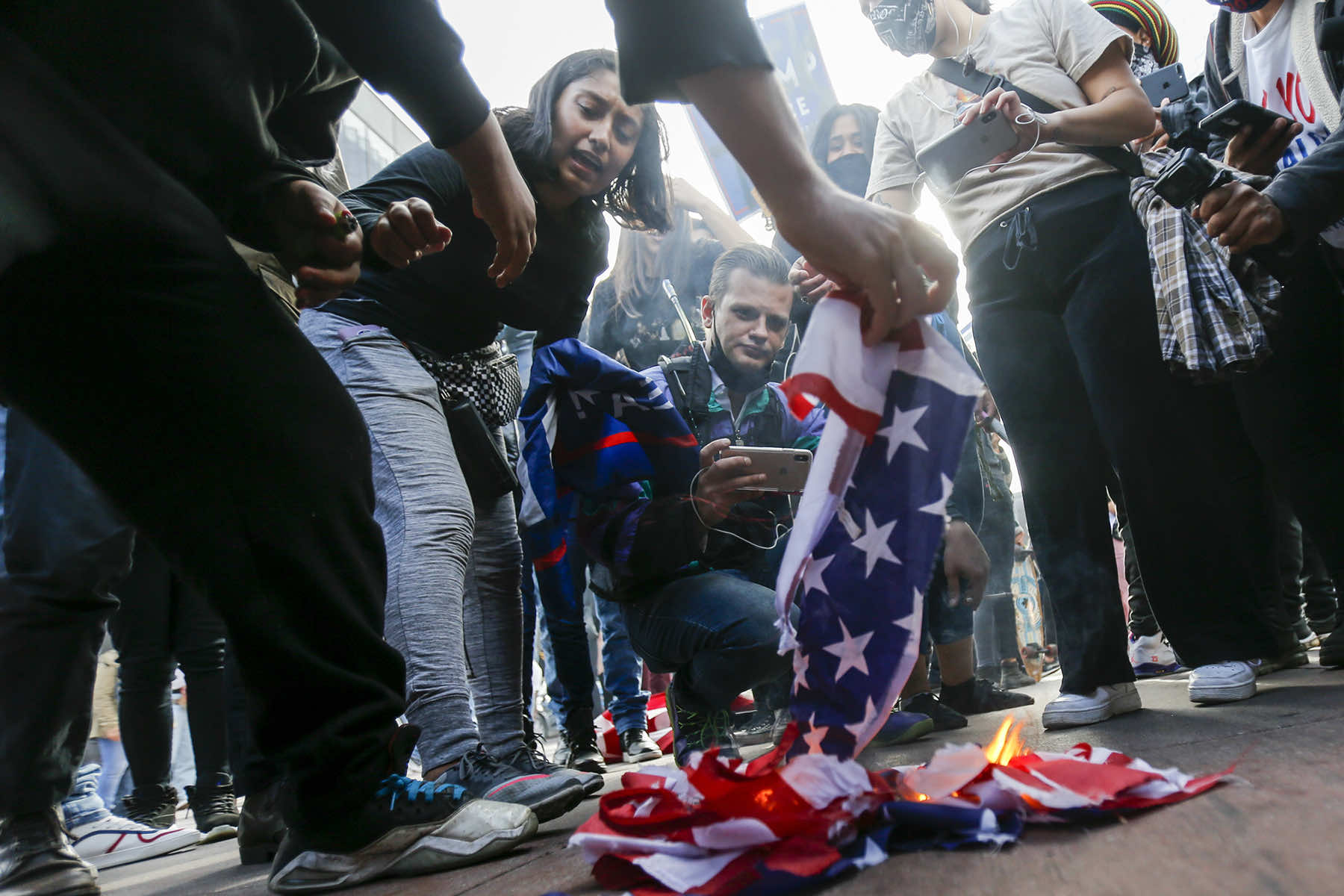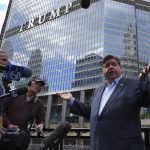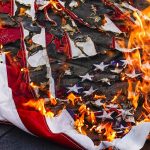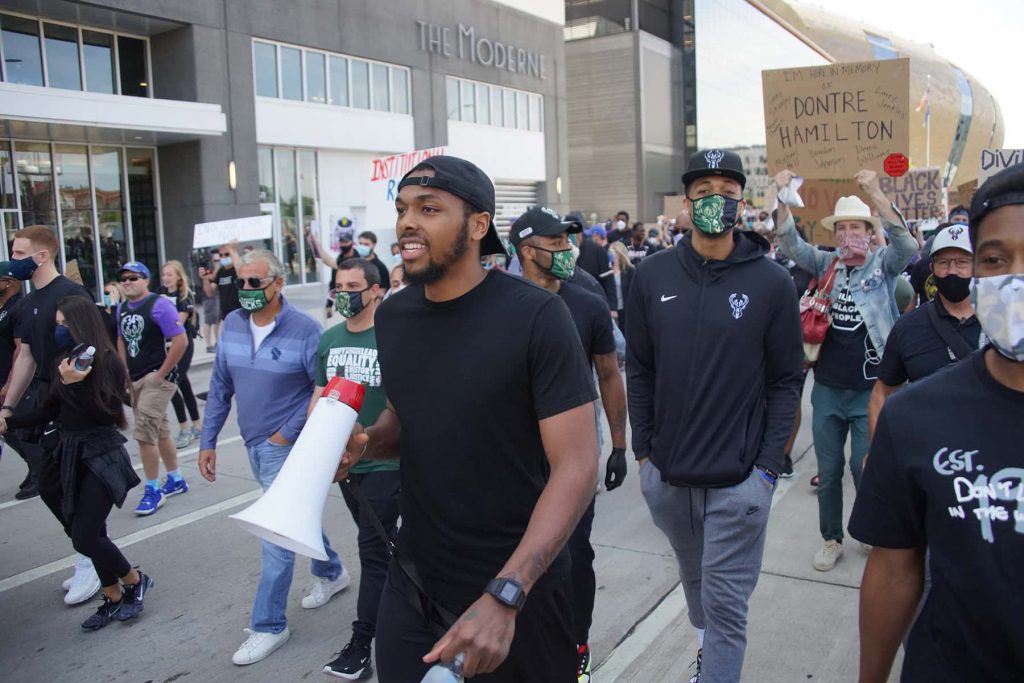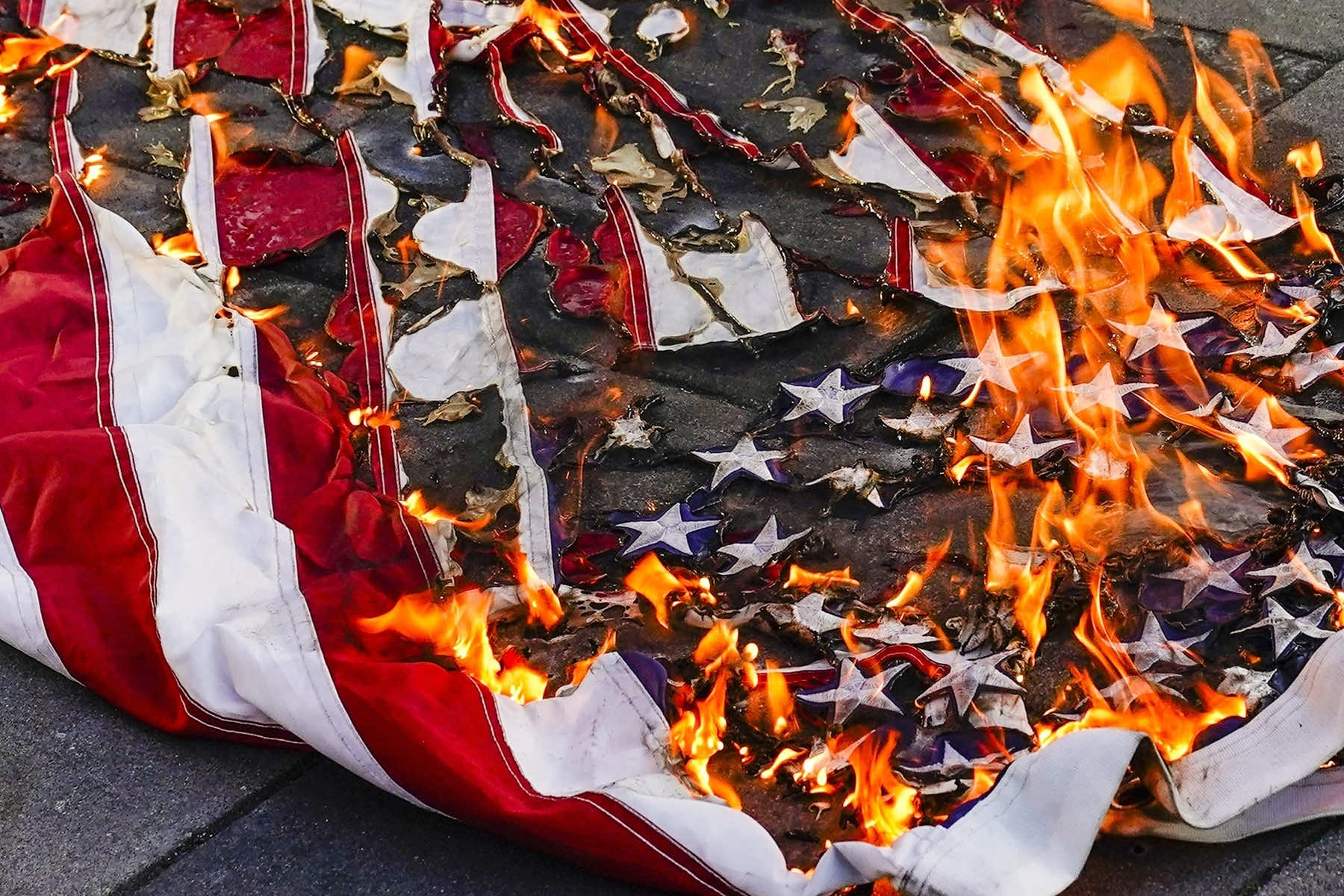
The late Supreme Court Justice Antonin Scalia said that if it were up to him, he would jail “every sandal-wearing, scruffy-bearded weirdo who burns the American flag.”
But the Constitution, the conservative hero noted in 2015, protects flag-burning as a form of free speech. And importantly: “I am not king” who can outlaw the act single-handedly.
Neither is President Donald Trump.
So on August 25, he signed an executive order that sets out to challenge the 5-4 Supreme Court decision that has stood since 1989, when Scalia joined the majority ruling that flag burning is a protected exercise of free speech.
Trump’s order says there is still room to prosecute flag burning under certain circumstances and urges Attorney General Pam Bondi to “vigorously prosecute those who violate our laws in ways that involve desecrating the American Flag.” Foreign nationals could face having their visas, residency permits, naturalization proceedings and other immigration benefits revoked, according to the order. They could also be deported.
It’s an effort to push the issue back toward the Supreme Court, which now holds a 6-3 conservative majority and could reconsider the 1989 decision. Three of the sitting justices were nominated by Trump.
Civil liberties advocates and constitutional scholars questioned both the legality and the merit of Trump’s action. A lawyer working for a free speech group said Trump does not have the power to rewrite the First Amendment.
“While people can be prosecuted for burning anything in a place they aren’t allowed to set fires, the government can’t prosecute protected expressive activity — even if many Americans, including the president, find it ‘uniquely offensive and provocative,'” added Bob Corn-Revere, chief counsel of the Foundation for Individual Rights and Expression.
Trump said burning the U.S. flag “incites riots at levels we’ve never seen before,” with some people “going crazy” over the act of setting it afire and others expressing anger at people for burning it. He did not offer examples.
“All over the country they’re burning flags. All over the world, they burn the American flag,” Trump said, as Vice President JD Vance, Bondi, Defense Secretary Pete Hegseth and other administration officials stood behind him as he sat at his desk.
G.S. Hans, a law professor at Cornell University who focuses on the First Amendment, said the country has not suffered from an “endemic of flag burning.”
“I don’t think this is something that has been a big problem,” Hans said in an interview. “It’s a solution in search of a problem.”
The executive order states that desecrating the American flag is “uniquely offensive and provocative. It is a statement of contempt, hostility, and violence against our Nation — the clearest possible expression of opposition to the political union that preserves our rights, liberty, and security. Burning this representation of America may incite violence and riot.”
The order calls on the attorney general to prioritize enforcement “to the fullest extent possible” of criminal and civil laws against flag burning that cause harm unrelated to the First Amendment’s free speech guarantee.
“Thank you for protecting the American flag, and we’ll do that without running afoul of the First Amendment as well,” Bondi told the president.
Trump’s obsession with the American flag extends beyond policy. His personal conduct at public events has made the flag not only a political flashpoint, but a theatrical centerpiece of his image.
He has long exhibited a penchant for molesting the American flag, most infamously through his theatrical, almost fetishistic displays of affection at political rallies. This behavior has included repeatedly hugging, stroking, and kissing the flag in ways critics describe as uncomfortable and performative.
At the 2019 Conservative Political Action Conference (CPAC), he grinned and clutched the flag tightly, running his hands over it and planting a kiss, a spectacle he would go on to repeat at other appearances. While his supporters have framed these moments as demonstrations of patriotism, detractors argue they reduce the flag to a prop for self-promotion, turning national symbolism into a sideshow.
TRUMP’S ORDER DOESN’T MAKE FLAG BURNING A CRIME
The order directs Bondi to prioritize enforcing laws against flag-burning incidents that “violate applicable, content-neutral laws, while causing harm unrelated to expression, consistent with the First Amendment.” The examples cited include crimes of hate, violence or against property.
During the signing ceremony, the president used foreboding words while signing the order — words that made it appear he has more power than he does.
“You burn a flag, you get one year in jail. You don’t get 10 years, you don’t get one month,” Trump said. “It goes on your record, and you will see flag burning stopping immediately.”
In fact, the limits on Trump’s authority were evident in the order itself. It made no mention of punishment for burning a flag — an acknowledgement, perhaps, that whatever Trump says, the president can’t set penalties for actions that the court has ruled are protected by the First Amendment.
Legislatures, Congress and in the 50 states, decide what’s illegal and set penalties for breaking the law.
But the president is particularly attuned to the power of images. A White House fact sheet referenced recent protests, including in Los Angeles in June, where the flag was burned “alongside violent acts and other conduct threatening public safety.”
And he may be right that “the people in this country don’t want to see our American flag burned and spit on,” although public opinion is complicated. A handful of polls over the past few decades show that most Americans found flag-burning to be unacceptable in general, but they were less likely to say it should be illegal when they were asked specifically about flag-burning as a form of political protest.
Trump’s order states that the sight of someone disrespecting an American flag — and particularly burning one — is “uniquely offensive and provocative.”
“It is a statement of contempt, hostility, and violence against our Nation,” the order continues, “the clearest possible expression of opposition to the political union that preserves our rights, liberty, and security.”
The tension between “free speech” and the symbolic importance of the flag
In 1984, Gregory Lee Johnson set fire to an American flag during a protest outside the Republican National Convention in Dallas, where Republican President Ronald Reagan was to be nominated for reelection. Johnson was sentenced to a year in prison and fined for violating a Texas law against “desecration of a venerated object.”
The case, Texas v. Johnson, made it to the U.S. Supreme Court, which ruled five years later in a 5-4 decision that Johnson’s act constituted expressive conduct protected by the First Amendment. Scalia, who has been repeatedly praised by Trump, joined the majority.
“We do not consecrate the flag by punishing its desecration, for in doing so, we dilute the freedom that this cherished emblem represents,” Justice William J. Brennan wrote for the majority. The ruling, he wrote, is “a reaffirmation of the principles of freedom and inclusiveness that the flag best reflects, and of the conviction that our toleration of criticism…is a sign and source of our strength.”
Shortly after that, Congress passed a law criminalizing flag burning but the court later struck it down.
That flag desecration is protected by the First Amendment doesn’t diminish the emotional charge of seeing one burned. A flag, after all, is the visual shorthand for a nation and its identity, values and legitimacy. It also stands as a symbol of the sacrifice made by servicemen and women in the armed forces, as well as their families and communities.
“Millions and millions of Americans regard it with almost mystical reverence, regardless of what sort of social, political or philosophical beliefs they may have,” Chief Justice William H. Rehnquist wrote in the dissent.
Free expression, he continued, is “of course, not absolute.” To the extent that flag burning is expression, he wrote, then “flag burning is the equivalent of an inarticulate grunt or roar that, it seems fair to say, is most likely to be indulged in not to express any particular idea, but to antagonize others.”
Opined Vice President JD Vance in a social media post on August 26: “Texas v. Johnson was wrong and William Rehnquist was right.”
TRUMP’S ORDER HAS ANGERED SOME CONSERVATIVES
Trump’s order inflamed even some conservatives who consider flag burning a long-settled matter of protected free speech.
“I would never in a million years harm the American flag,” conservative talk radio host Jesse Kelly said on social media. “But a president telling me I can’t has me as close as I’ll ever be to lighting one on fire. I am a free citizen. And if I ever feel like torching one, I will.”
Republican President George H.W. Bush ran against flag burning in 1988 and spent a week campaigning on the issue, recalled Brit Hume, chief political analyst on Fox News Channel. But Bush called for a constitutional amendment to ban the practice.
“He didn’t pretend he could ban it by an executive order that flies in the face of constitutional speech protections,” Hume said on social media.
Scalia’s son, Christopher, reposted a quote from his father on the subject.
“As I understand the First Amendment,” Antonin Scalia said, “it guarantees the right to express contempt for the government, the Congress, the Supreme Court, even the nation and the nation’s flag.”
FLAG-BURNING HAS BEEN ON TRUMP’S MIND FOR YEARS
After he was elected president in November 2016, Trump said, “there must be consequences” for anyone who burns an American flag, such as jail or loss of citizenship.
“Nobody should be allowed to burn the American flag — if they do, there must be consequences — perhaps loss of citizenship or year in jail!” Trump wrote on what was then Twitter.
The Constitution forbids the government from stripping citizenship from natural-born Americans.

